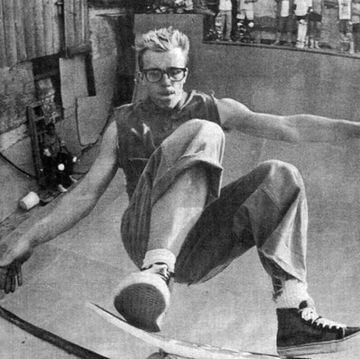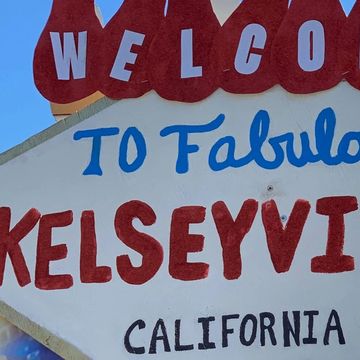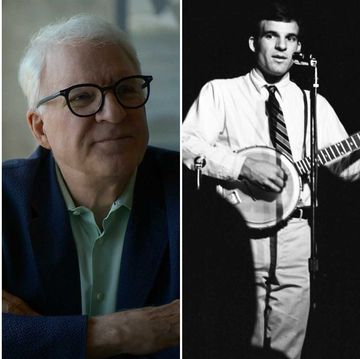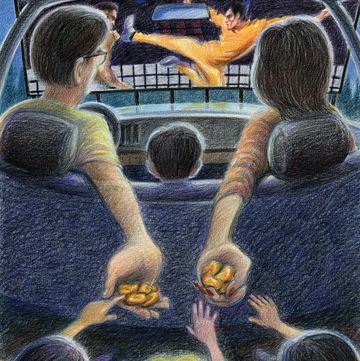Silence. A thousand square miles of empty desert, picked up by a HIGH CAMERA, PANNING almost imperceptibly.
The CAMERA PICKS UP a road through the desert, and stops. An open car comes INTO FRAME, driven very fast along the desert road. The driver is MARIA. She is aiming a gun at a road sign as she drives.
So begins Joan Didion and John Gregory Dunne’s screenplay for Play It As It Lays, based on Didion’s 1970 novel. It was her second novel and the couple’s second tag-teamed script, after The Panic in Needle Park. Other credited works to follow would include A Star Is Born, True Confessions, and Up Close & Personal. Play It As It Lays was directed by Frank Perry and coproduced by Dunne’s older brother Dominick Dunne. It may not be the most successful of the couple’s filmic endeavors, box office–wise, but the movie and its script have the tug of an archaeological find: a shard, the fragment of some lost culture.
Tuesday Weld portrays Maria Wyeth, the somewhat estranged, soon-to-be-ex wife of director Carter Lang and our guide through the empty space of their slice of Hollywood. She was his star for two pictures: one that was never released, called Maria; the other, Angel Beach, about a motorcycle gang. Her star did not continue its ascent.
This article appears in the Spring 2022 issue of Alta Journal.
SUBSCRIBE
The film opens with an elegantly clad Maria walking and thinking, her thoughts in voice-over. We learn she’s in a sanatorium. A very posh one, if the grounds she wanders are any indication. Play It As It Lays is Maria’s account of how she got there. It is a tale of a marriage disintegrated possibly because Maria and Carter’s young daughter has been institutionalized. It is the story of an abortion and its aftermath, too. Most of all, it’s a study of Hollywood denizens benumbed but still capable of bouts of arid and cruel wit. If that sounds like a grim forecast, it is.
The character Maria began in earnest (perhaps not an apt word for a discussion of Didion’s gifts) when the author saw an actress in a white halter dress crossing the casino floor of Las Vegas’s Riviera Hotel at one o’clock in the morning. Not only did that woman stoke Didion’s imagination, but she also helped the author relocate her second novel from New York City to Los Angeles and Nevada. Didion, who’d been an editor at Vogue, had been thinking of her protagonist as a model; now she could see she was a model-actress. Of the process of bringing Maria to the page, Didion told the Paris Review, “I made notes and wrote pages over several years, but the actual physical writing—sitting down at the typewriter and working every day until it was finished—took me from January until November 1969.” The novel was published in 1970. The film was released in October 1972.
Early in the novel, Maria tells readers how to pronounce her name—it’s “pronounced Mar-eye-ah, to get it straight at the outset.” The pronunciation is carried over to the film, and if you are of a certain age, once you hear her name, a tenaciously popular hit song from the 1951 musical Paint Your Wagon might wedge in your inner ear. “Maria makes the mountains sound / Like folks were up there dying / Maria / Maria / They call the wind Maria…” That song, like this movie, is about a profound and wind-scoured loneliness.
Only the first 44 pages of the screenplay seem to have been published; they were included in a 1972 promotional paperback for upcoming titles from the Literary Guild of America. Publication of Play It As It Lays would seem to be a special case. The fact that authorized copies of Didion-Dunne screenplays aren’t readily available may say something about where the duo ranked their writers-for-hire work. They were highly professional, according to director Jon Avnet, with whom they bumped heads over the script for the journalists-in-love drama Up Close & Personal (they became his friends and go-to polishers), but were perhaps a little mercantile about the screen work, nonetheless.
If those early script pages are an indication, then Perry hewed closely to what Didion and Dunne had crafted. And the screenplay is decidedly faithful to the novel. There are trims and compressions, to be sure. Talent agent Freddy Chaikin—who borrows a client’s jet, flies to Vegas, and gets Maria out of a jam—is no more. His best lines have been passed along to another character, his grand rescue now just a long drive from L.A. to Las Vegas. The casual racism and homophobic slurs of the novel remain. There are some fresh lines of dialogue that add depth and breadth to the sinkhole that is the biz. “That’s what I like about you, Carter. A cult director with a nose for commerce,” says Carter’s friend and producer BZ Mendenhall early on.
To their great credit, Weld and Anthony Perkins (who plays BZ) make sympathetic a friendship that is vague in the novel. The screenwriters and the director must have sensed that the audience would crave someone to care about in this freeway-ringed, highway-bisected purgatory.
“Don’t you ever get tired of doing favors for people?” Maria asks BZ, a quasi-closeted gay man with a glam and gossipy wife who’s overly tight with her mother-in-law. BZ answers with a kind of poignance that may have you wanting to work back through Perkins’s filmography for his tender turns, not his freak-flag monsters: “You don’t know how tired.” Soon enough, we will.
Like the novel, the film brings a hazy sunlight to bear on a kind of existential gloom. These characters amble toward nihilism. Nearly all are insufferable, in the book and in the film. But Didion has a taut grasp of the milieu in which she locates them. And she and Dunne impressively make the malaise into the film’s mise-en-scène. The mood is a character. It’s the kind of boredom, self-importance, and self-medicating that prefigured Sofia Coppola’s L.A.-set films Somewhere and The Bling Ring by four decades. Boredom, thy upscale name is ennui.
Still, if there’s a quintessential character linking the episodic novel and the equally fractured film, it is the freeway. Or freeways. The intercut images of Maria driving endless miles of them—sometimes from above, sometimes at road level—are almost comical. They seem the purview of an experimental filmmaker, which Perry was not. Maria revs along, conversations she’s had playing in voice-over. At one point, the road signs seem to mimic the Wizard of Oz scarecrow’s opposite-direction advice. On the tight shoulder of a busy freeway, a CHP officer stops to help the young woman with the yellow Corvette convertible change a tire. No need, Maria says, looking her most relaxed. He tries to insist, asks her where she’s headed. “I’m not going anywhere,” she tells the patrolman. And for a spell, the movie doesn’t seem to be headed anywhere either.
Freeway—the word promises so much: if not quite a liberation, at least a betwixt and between space. Or, as Maria says to the officer, looking off with a faint smile, “I mean…it makes you feel as if they had some reason in mind when they built it, you know what I mean?”
Another California-bred author whose consummate prose also put her in a pantheon didn’t think much of Maria. And if Pauline Kael’s New Yorker movie review is an indicator, she wasn’t particularly awed by Maria’s creator, either. “I found the Joan Didion novel ridiculously swank,” Kael wrote in her 1972 slam. “And I read it between bouts of disbelieving giggles. I whooped at the first line…. I whooped at the ending…. Certainly I recognize that Miss Didion can write: the smoke of creation rises from those dry ice sentences. You know at once that you’re in the fast company of Butterfield 8 and Miss Lonelyhearts and The Day of the Locust and Fitzgerald and Zelda herself. But you also know that this is what movies have done to the novel.”
It’s possible that, far more than Kael, Didion and Dunne grasped something particular about Hollywood—not its on-screen products but its place-no-place soullessness. They were boots-on-the-ground, or toes-in-the-sands. They lived in Los Angeles from 1964 to 1988. On the occasion of Didion’s passing, Los Angeles–based film writer Anne Thompson wrote for IndieWire, of Didion and Dunne, “They knew the town better than anyone.” Or the town within the town—the one they were participant observers of. Indeed, the climax of both book and movie is, according to the late writer Eve Babitz, a twist on a story that singer Michelle Phillips liked to tell about her role in a friend’s suicide attempt.
“Someday you’ll wake up and you just won’t feel like playing anymore,” BZ says to Maria moments before he drifts off into the big sleep. Looking at us from the walkway of the sanatorium, she reminds us that she’s no nihilist, that she’s no quitter. Why? you may wonder. “Why not?” she says.•
Lisa Kennedy writes about film, theater, and culture. She lives in Denver, teaches nonfiction writing, and is at work on Icarus Ascending, a memoir set during the early years of the AIDS crisis. Since returning to the West after years on the East Coast, she has often looked to Joan Didion to grapple with writing about place.













